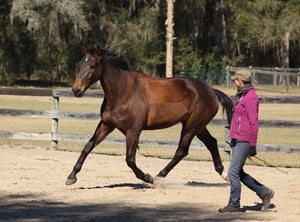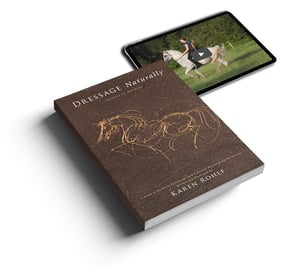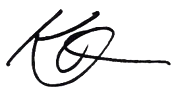A quick video message from Karen about the exercise in this blog.
The following is an excerpt from my book: Dressage Naturally... Results In Harmony. A Guide To The Basics Of Dressage From A Natural Horsemanship Perspective. Pages 47-48.
EXERCISE 1 Assess your horse
Go out and observe your horse, but pretend that I have sent you to a stable to look at a horse for me and to report back what you observe. Remember it is about observing, not judging! And here is the really hard part: I would like you to pretend you have never seen this horse before. We may miss really seeing what our horse is offering if we are wearing glasses that are imprinted with the past. Don’t take too long for this (15 minutes maximum). You could make this easier by observing some horses that you really haven’t seen before!
“We may miss really seeing
what our horse is offering if we are wearing glasses that are imprinted with the past.”
For example, see how you would describe:
-
The basic attitude — the feeling he gives you when you play with him (confident, scared, bold, sweet, friendly, oppositional, confused etc). Remember there are basic horse ‘personalities’ (playful, introverted, etc), and then any ‘personality’ can have moments that boil down to feelings of safety (confidence, thinking) or fear (acting on instincts). See if you can make a best guess about what you are seeing in this moment.
-
 The quality of movement your horse offers. For example:
The quality of movement your horse offers. For example:-
Freedom and regularity of gaits
-
Energy, activity of hind legs, relaxed spine
-
Attention, confidence
-
Lightness of forehand, ease of movements
-
Feel on the line
-
Clarity of communication
-
Responsiveness
-
-
What do the gaits look like? Don’t worry about using the correct technical term, just describe what you see (bouncy, stabbing, fluid, elastic, flat). See how much you already know!
-
What are you able to ‘talk’ to this horse about? If he is low energy, what happens if you ask him for more energy? If he is not paying attention, what happens when ask for his attention? Again, just experiment... you are not training or being tested, you are just gathering information.
-
When does his posture and movement look the most like a 'dressage horse'? When does it look the furthest from your target?
Which parts of his body move the most freely? Which seem tight or stiff?
Do his hind legs spend more time under his body or pushing our behind? How does that change at different energy levels?
I have observed that Natural Horsemanship students can easily talk about their horse’s mental/emotional state, but have trouble describing the horse physically. Challenge yourself to describe their body... don’t worry about being technical, just practice observing, increasing your awareness and ability to assess.
*Hint: If you are having trouble, have a friend bring another horse out, or have someone else move the horse so that you can observe him and another horse from an outside perspective. Sometimes it is easier to compare (which horse is freer in his movement, which horse seems more balanced, etc.)
Now that you have had this short time with this horse, pretend I call you on the phone and you must tell me, as concisely as possible, as much information about the horse.
If you have a friend it can be fun to have them ask you the above questions, and they should point out every time you refer to the past (“he’s more energetic than usual”) by saying: “but how do you know that if you’ve never seen this horse before?” Also practice being concise (pretend this is costing you $10/minute!). Do this on-line and riding. Write down your observations.
Keep this list somewhere and every now and then, repeat this exercise as if this is the first time seeing the horse. It can be very interesting to compare the new list to the original list.

Get THE book
for doing dressage in partnership
(includes 3 hours of companion video)
Then answer these questions as concisely as possible for the horse:
-
“What is a positive feature that I would like to keep?”
-
“If only _________________ was better, I think everything would be better.”
-
“How would my horse answer those questions about me?” ‘I like that my human _______________’, and ‘if only my human changed ________________ I think everything would be better.’
If you liked this excerpt, you'll LOVE the book (it comes with 3 hours of video).



